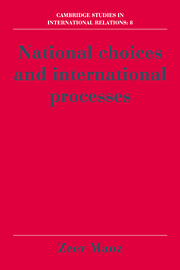Book contents
- Frontmatter
- Contents
- List of figures
- List of tables
- Preface
- 1 Toward a theory of international processes
- 2 Foreign policy decision making: assumptions and characterization of the approach
- 3 The inputs of decision making: identification and conceptualization
- 4 The essential mathematics of inputs
- 5 Models of the decision process
- 6 A formal characterization of decision processes
- 7 A theory of foreign policy decision making
- 8 The analysis of international outcomes
- 9 The evolution of international processes
- 10 Individual preferences, national choices, and international systems
- References
- Name Index
- Subject Index
2 - Foreign policy decision making: assumptions and characterization of the approach
Published online by Cambridge University Press: 05 February 2012
- Frontmatter
- Contents
- List of figures
- List of tables
- Preface
- 1 Toward a theory of international processes
- 2 Foreign policy decision making: assumptions and characterization of the approach
- 3 The inputs of decision making: identification and conceptualization
- 4 The essential mathematics of inputs
- 5 Models of the decision process
- 6 A formal characterization of decision processes
- 7 A theory of foreign policy decision making
- 8 The analysis of international outcomes
- 9 The evolution of international processes
- 10 Individual preferences, national choices, and international systems
- References
- Name Index
- Subject Index
Summary
INTRODUCTION
Foreign policy decision making analyses are viewed as microlevel approaches to world politics (Dougherty and Pfaltzgraff, 1971: 315; K. Holsti, 1988: 7–9). This is due to (a) the focus of these approaches on relatively limited and well-defined decisional units, (b) the focus on discrete and limited sequences of events rather than on global processes, trends, or patterns over an extended domain of time and space, and (c) the limited set of issues they seek to explain. Decision making approaches offer a limited, but very useful, outlook of politics as a problem-solving process.
Despite their limited scope and their seeming reductionist nature, foreign policy decision making approaches are essential to a thorough examination of world politics. As Bueno de Mesquita and Singer (1973: 238) put it: “no matter how many types of predictor variables we use in our model, or how many levels of analysis we embraced, we fall short of explanation until we demonstrate how the individuals who made (or acquiesced in) the key decisions served as the ‘causal’ link in the sequence [of events or processes to be explained].”
Decision making is often assumed to have an intervening rather than an exogenous role in explanations of international relations and national behavior. It is the glue that connects basic explanatory factors at the systemic, national, and societal levels to national and international behavior.
- Type
- Chapter
- Information
- National Choices and International Processes , pp. 37 - 49Publisher: Cambridge University PressPrint publication year: 1990

